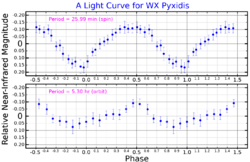Astronomy:WX Pyxidis
From HandWiki
Short description: Star in the constellation Pyxis
 Near-infrared (J band) light curves for WX Pyxidis, showing variation over the white dwarf rotation period (top) and orbital period (bottom). Adapted from Joshi et al. (2011)[1] | |
| Observation data Equinox J2000.0]] (ICRS) | |
|---|---|
| Constellation | Pyxis |
| Right ascension | 08h 33m 05.7636s[2] |
| Declination | −22° 48′ 31.981″[2] |
| Apparent magnitude (V) | 16.2 - 17.74[3] |
| Characteristics | |
| Spectral type | white dwarf + M2[1] |
| Variable type | Intermediate polar |
| Astrometry | |
| Proper motion (μ) | RA: −4.627[2] mas/yr Dec.: 1.378[2] mas/yr |
| Parallax (π) | 0.5991 ± 0.0851[2] mas |
| Distance | 1530[1] pc |
| Details | |
| White dwarf | |
| Mass | 1.4[4] M☉ |
| Other designations | |
1E 0830.9-2238[5] | |
| Database references | |
| SIMBAD | data |
WX Pyxidis is a cataclysmic variable star system in the constellation Pyxis. Its X-ray emissions were discovered in 1984, after which a visual correlate was searched for. It is classed as an intermediate polar system, composed of a white dwarf and red dwarf with a calculated spectral type of M2V in close orbit around each other and the spin of the degenerate star is such that it does not present the same face to the other star.[1] The degenerate star spins on its axis every 25 minutes.[6] The stars are estimated to take 5.3 hours to orbit each other and the system is 1530 parsecs distant.[1]
References
- ↑ 1.0 1.1 1.2 1.3 1.4 Joshi, V.H.; Ashok, N.M.; Banerjee, D.P.K. (2011). "A study of the near-infrared modulation at spin and orbital periods in the intermediate polar WX Pyx". Bulletin of the Astromical Society of India 39: 259–75. Bibcode: 2011BASI...39..259J.
- ↑ 2.0 2.1 2.2 2.3 2.4 Brown, A. G. A. (August 2018). "Gaia Data Release 2: Summary of the contents and survey properties". Astronomy & Astrophysics 616: A1. doi:10.1051/0004-6361/201833051. Bibcode: 2018A&A...616A...1G. Gaia DR2 record for this source at VizieR.
- ↑ Samus, N. N.; Kazarovets, E. V. et al. (2017). "General Catalogue of Variable Stars". Astronomy Reports 61 (1): 80–88. doi:10.1134/S1063772917010085. Bibcode: 2017ARep...61...80S. http://www.sai.msu.su/gcvs/gcvs/. Retrieved 2019-11-23.
- ↑ Evans, P. A.; Hellier, Coel (2007). "Why do Some Intermediate Polars Show Soft X‐Ray Emission? A Survey of XMM‐Newton Spectra". The Astrophysical Journal 663 (2): 1277–1284. doi:10.1086/518552. Bibcode: 2007ApJ...663.1277E.
- ↑ "V* WX Pyx". SIMBAD. Centre de données astronomiques de Strasbourg. http://simbad.u-strasbg.fr/simbad/sim-basic?Ident=V%2A+WX+Pyx.
- ↑ Schlegel, E. M. (2005). "A serendipitous XMM-Newton observation of the intermediate polar WX Pyx". Astronomy and Astrophysics 433 (2): 635–39. doi:10.1051/0004-6361:20042314. Bibcode: 2005A&A...433..635S.
 |

